

Whole Kids Foundation - Honey Bees. Which Veggies for Which Season? - Bonnie Plants. Collards, cabbage, spinach, and kale are among the most cold-hardy vegetables.
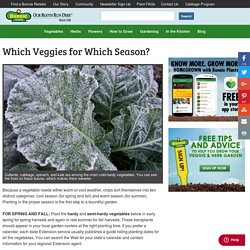
You can see the frost on these leaves, which makes them sweeter. Because a vegetable needs either warm or cool weather, crops sort themselves into two distinct categories: cool season (for spring and fall) and warm season (for summer). Planting in the proper season is the first step to a bountiful garden. FOR SPRING AND FALL: Plant the hardy and semi-hardy vegetables below in early spring for spring harvests and again in late summer for fall harvests. These transplants should appear in your local garden centers at the right planting time. Hardy vegetables tolerate hard frosts (usually 25 to 28 degrees F). BroccoliBrussels sproutsCabbageCollards*English peasKaleKohlrabiLeeksMustard greensParsleyRadishSpinachTurnip Lettuce and chard are among the veggies that will grow well in spring and fall, but need to be covered if temperatures dip much below freezing. Related Fall Gardens Make Sense August 30, 2011.
Lesson Plans. Great lesson plans make any new classroom project a cinch!

Over the years, Growing Minds has developed Farm to School activities that incorporate state and national curriculum. Teachers are currently using these plans throughout Southern Appalachia and beyond. Find lesson plans in the list below or take a look at our Get Local @ School section to find lesson plans, recipes, books, and other resources for each month of the school year. All Growing Minds lesson plans have connections to the Common Core, Essential Standards, and age-appropriate literature. Preschool Preschool Lesson Plans – Exploring local food and farms with your young learners doesn’t have to be challenging! Recipe Lesson Plans – Kid tested and teacher approved recipes for each month of the school year. Harvesting Onions (National Gardening Association) There's never a time when onions aren't ready for harvesting.
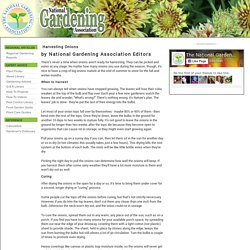
They can be picked and eaten at any stage. No matter how many onions you use during the season, though, it's nice to have a crop of big onions mature at the end of summer to store for the fall and winter months. My Natural Garden Pest Control. I’m proud to announce that my fall garden is goin’ strong, thanks to my natural garden pest control!
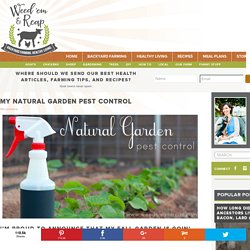
I’ve got my soil composted, organic heirloom seeds planted, labels painted, and my day laborers (a.k.a. the children) weedin’ like nobody’s business. It’s the stuff of dreams, man.1 Being a natural person, I wanted to go for natural garden pest control. My garden was doing fine in the beginning, and then came that little pesky problem… Feeding Your Composting Worms. Keep shredded black and white newspaper over the food at all times.
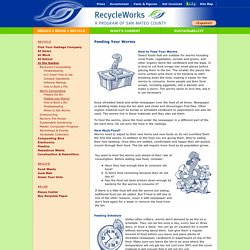
Newspaper or bedding helps keep the bin dark and moist and discourages fruit flies. Other organic material such as burlap or shredded cardboard or paperboard can also be used. The worms live in these materials and they also eat them. To feed the worms, place the food under the newspaper in a different part of the bin each time. Do not bury the food in the castings.
Urban Worm Composting - How To: Six Easy Steps to Setting Up a Worm Bin - Cornell Composting. By Jen Fong and Paula Hewitt Once you have worms and a bin, follow these six easy steps to set up a worm bin.
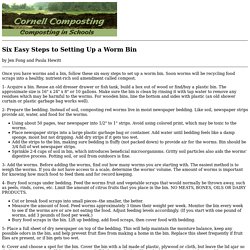
Soon worms will be recycling food scraps into a healthy, nutrient-rich soil amendment called compost. 1- Acquire a bin. Reuse an old dresser drawer or fish tank, build a box out of wood or find/buy a plastic bin. The approximate size is 16" x 24" x 8" or 10 gallons. 2- Prepare the bedding. Using about 50 pages, tear newspaper into 1/2" to 1" strips. 5 Steps to Quick Compost. Photo: Francesca Yorke/Getty Images Rapid or "hot" composting is a great option for impatient gardeners who don't want to wait the 6 to 12 months it takes for most compost piles to mature.
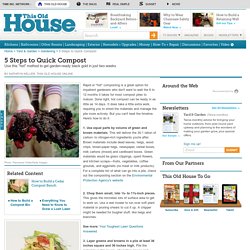
Done right, hot compost can be ready in as little as 14 days. It does take a little extra work, requiring you to shred the materials and manage the pile more actively. But you can't beat the timeline. Here's how to do it: 1. Photo: Wally Eberhart/Getty Images. Growing Vegetables in Containers. Happily, most vegetables aren't fussy about what kind of vegetable container garden they grow in.

The only basic requirements is that the vegetable container garden is large enough to hold the plant and that it has drainage holes so excess water can escape. When it comes to size, the bigger the pot is, the better, especially for beginners. The reason for this is that large pots hold more soil—and thus, hold moisture longer so you don't have to water as much. Look for vegetable container gardens that are at least 10 inches wide and 12 inches deep. Large flowerpots, half barrels, plastic-lined bushel baskets, window boxes, planters, and large containers (like 5-gallon buckets) work just fine.
Sites-Gardeners-Site.